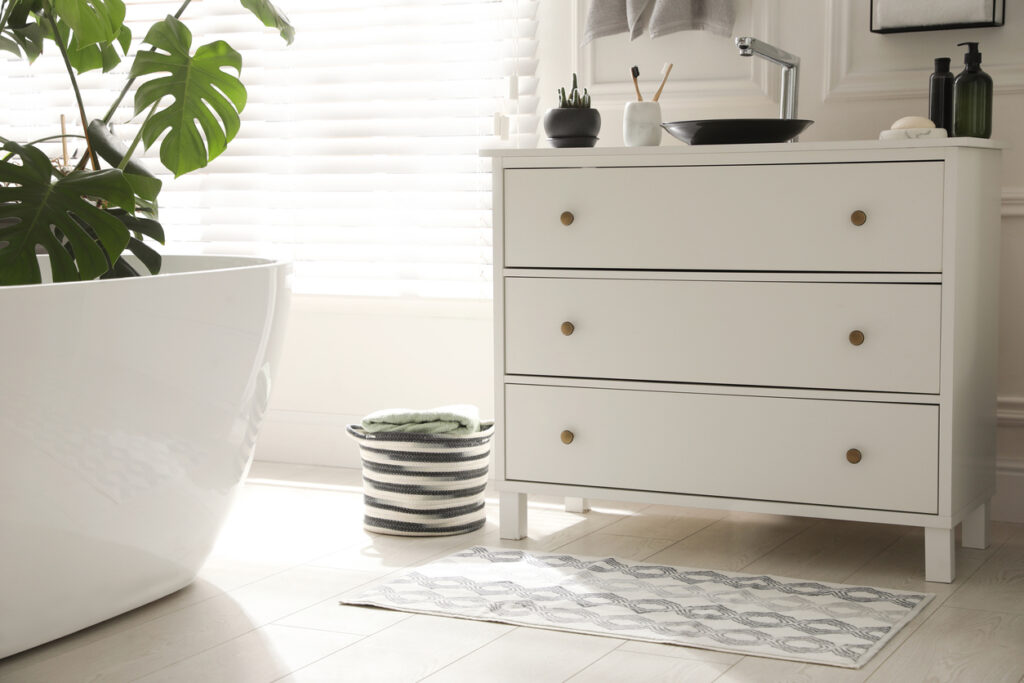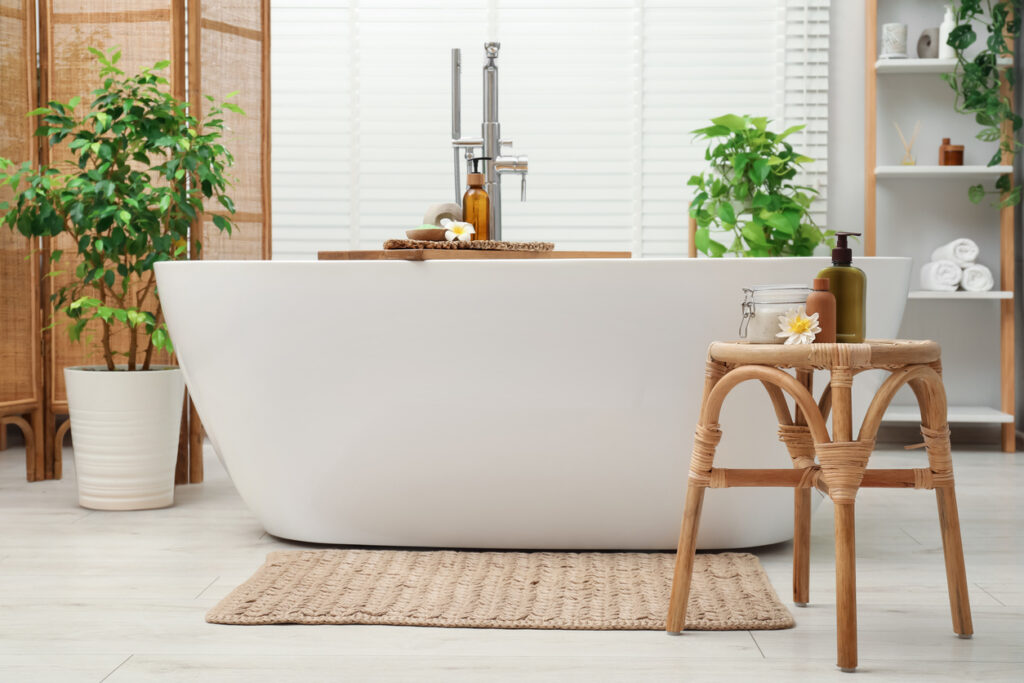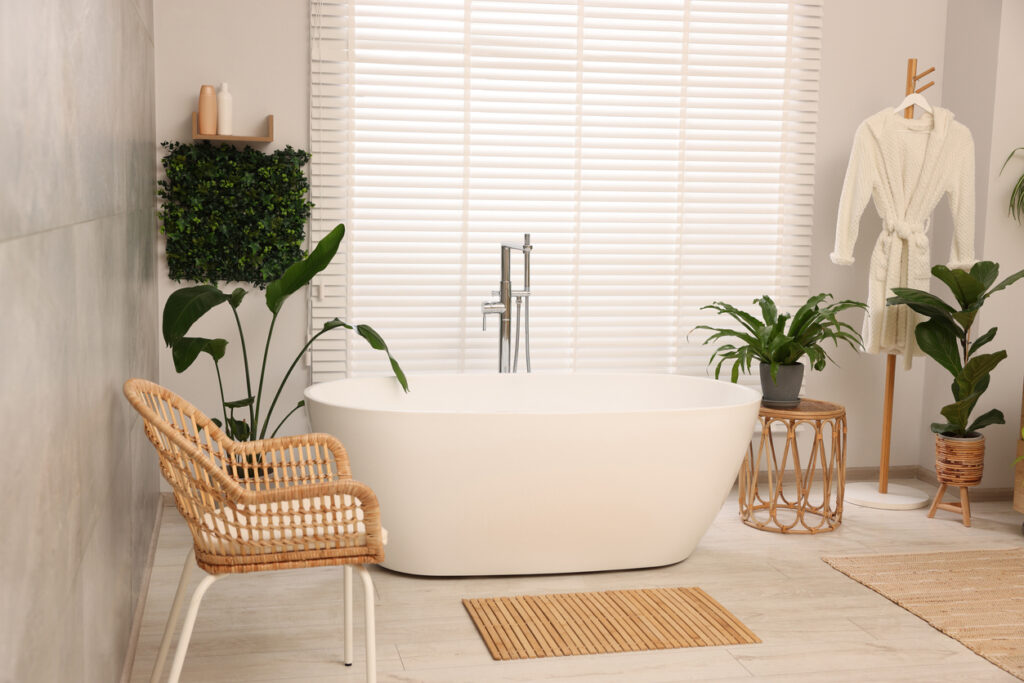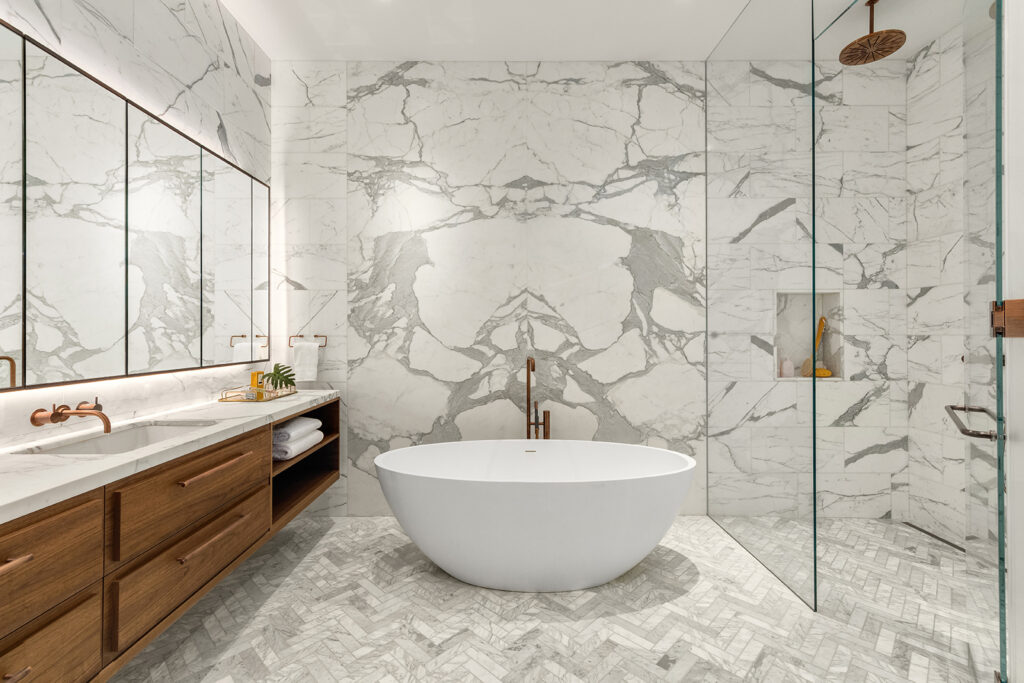
One-Piece vs Two Piece Toilet – Pros and Cons- 2025 Expert Guide
When upgrading your bathroom, one of the most important—and often overlooked—decisions is choosing between a one-piece or two-piece toilet. While
Small details, including what you place on the floor, can make a big difference when setting up or upgrading your bathroom. While many use the terms “bath mat” and “bath rug” interchangeably, they serve different purposes and are made from distinct materials. Understanding the differences can help you make the right choice for comfort, functionality, and style.
Most homeowners want both comfort and practicality in their bathroom. Whether you’re trying to absorb post-shower water, prevent slips, or enhance your decor, choosing between a bath mat and a bath rug comes down to understanding their purpose, durability, appearance, and maintenance needs. Confusion often arises because they look similar but don’t behave the same.

The bath mat is your go-to for post-shower practicality, while the bath rug leans into decorative comfort and coziness. Depending on your bathroom needs, you may even benefit from having both.
| Feature | Bath Mat | Bath Rug |
| Purpose | Functional – absorbs water & prevents slips | Decorative – adds comfort and style |
| Material | Usually cotton or microfiber with non-slip backing | Plush, luxurious materials like chenille or polyester |
| Water Absorption | High water absorption | Moderate to low absorption |
| Safety Features | Designed with non-slip backing | May or may not have non-slip features |
| Style Options | Basic styles, utilitarian | Wide range of colors, textures, and patterns |
| Placement | Right outside the shower or tub | Anywhere in the bathroom |
| Cleaning | Machine washable | Some are washable, others require special care |
| Cost | Affordable ($10–$30) | Can be more expensive ($25–$80+) |
Bath mats are essential for maintaining both cleanliness and safety in the bathroom. Often underestimated, these practical accessories prevent slips and keep floors dry after bathing or showering. While they may appear simple, bath mats are designed with highly absorbent materials and often feature anti-slip backing to serve a very specific and functional purpose. This section’ll explore what bath mats are, how they’re commonly used, and what features set them apart.
A bath mat is a compact, absorbent textile placed just outside the bathtub or shower. Its main function is to catch excess water as you step out, creating a safer, drier environment. Unlike standard rugs, bath mats are made from quick-drying materials and typically feature non-slip backing to prevent accidents on slippery tiles. Though their appearance is often minimal, their utility is crucial in any bathroom setup.
Bath mats are more than just an accessory—they’re functional tools designed to improve your bathroom experience in several key ways:
Slip Prevention – One of the primary reasons people use bath mats is to prevent slips after stepping out of the shower or tub. Wet bathroom floors can be dangerous, especially for children and older adults. Bath mats often include non-slip backing to help keep the mat securely in place and reduce the risk of falls.
Moisture Absorption – Bath mats absorb the water that drips off your body after bathing, keeping the floor underneath dry and safe. This minimizes puddles that can cause accidents and helps preserve your flooring. Without a bath mat, moisture can seep into tile grout, wood, or laminate, leading to long-term damage.
Hygiene and Cleanliness – By trapping water and keeping it contained, bath mats prevent excess moisture from spreading around the room. This helps reduce the growth of mold and mildew in high-moisture areas. Regular washing of bath mats keeps your bathroom cleaner and more sanitary overall.
Comfort Underfoot – While function comes first, comfort is a close second. Stepping onto a soft, absorbent mat is much more pleasant than landing on cold, hard tile. Bath mats offer a cozy landing spot that adds warmth and texture to your morning routine.
The shape of your bath mat doesn’t just affect how it looks—it influences how well it fits into your bathroom layout and how effectively it serves its purpose. While rectangular mats are the most common, other shapes are available to meet specific needs or design preferences.
This is the most common shape and is ideal for placing directly in front of a shower or tub. It offers full foot coverage as you step out while maximizing water absorption in one key area. Rectangular mats are versatile and available in a wide range of sizes.

Contour bath mats are designed to fit snugly around the base of a toilet. They help prevent water splashes from reaching the floor and add an element of design cohesion to the space. However, they’re often used more for appearance than heavy-duty absorption.
These shapes are used less frequently but offer a softer, more decorative look in larger bathrooms. While they still serve a practical function, oval or round mats are typically chosen to match a specific style or bathroom layout. They may work well near vanities or corner tubs.

The material of a bath mat plays a major role in how well it absorbs water, how quickly it dries, and how soft it feels underfoot. Choosing the right material can help you balance comfort, durability, and ease of care.
Cotton bath mats are highly absorbent and naturally soft. They’re breathable and machine washable, making them a practical everyday option. However, they may take slightly longer to dry than synthetic alternatives.

Microfiber mats dry quickly and are extremely effective at absorbing water. They’re also lightweight and resistant to mildew when properly cared for. Many come with memory foam padding for added comfort.

These eco-friendly options are less about softness and more about spa-like aesthetics and water drainage. Bamboo mats don’t absorb water but instead allow it to pass through and evaporate quickly. They’re ideal for people who prioritize clean lines and minimal upkeep.

Bath mats are available in several sizes to suit different bathroom layouts and safety needs. Small bath mats, usually around 17″ x 24″, are perfect for compact bathrooms or half-baths where space is limited. Medium-sized mats, such as 20″ x 30″, are the most common and are designed to sit comfortably outside a standard bathtub or shower. Large bath mats, which can measure up to 24″ x 36″ or more, provide wider coverage and are ideal for larger bathrooms or for catching excess water in front of wide shower doors or double tubs.
Bath mats are available at a variety of price points, making them accessible for nearly any budget. Understanding the general cost range can help you choose a mat that meets your needs without overspending—or underdelivering on comfort and safety.
These mats are usually made of basic cotton or microfiber and provide decent absorption and safety features. They may not be as durable or luxurious but get the job done in a pinch. Ideal for small bathrooms or temporary setups.
These options typically offer higher-quality materials, better design, and enhanced grip features. They may also include memory foam or quick-dry tech. This is the sweet spot for balancing comfort, performance, and cost.
Premium bath mats include designer patterns, eco-conscious materials, or specialty features like antibacterial coatings. These are ideal for spa-style bathrooms or people who want their bath mat to make a visual statement. They’re also more likely to be durable and long-lasting.
Bath Matts –
Bath mats are a functional staple in any bathroom, offering practical benefits like slip resistance, moisture absorption, and easy cleaning. They’re designed to be highly utilitarian, with features that support safety and hygiene more than decor. With a wide variety of materials, shapes, and price points, there’s a bath mat to suit nearly every household’s needs and preferences. But what if you’re looking for something more stylish, plush, or decorative?
That’s where bath rugs come in. While they may seem similar to bath mats at first glance, bath rugs are built for comfort and aesthetics—and offer a very different bathroom experience.
Bath rugs offer a softer, more decorative alternative to the functional bath mat. While they still provide some moisture absorption, their primary focus is on comfort, warmth, and enhancing the visual appeal of your bathroom. Ideal for larger or design-forward spaces, bath rugs can turn a basic bathroom into a cozy, spa-like retreat.
While bath mats focus on function, bath rugs lean into comfort and design. A bath rug is a soft, often plush textile used to enhance the look and feel of your bathroom while offering some moisture absorption. It’s designed more like a traditional area rug and is commonly placed near vanities or larger open floor areas. Unlike bath mats, bath rugs may not always include slip-resistant backing or quick-dry materials.
Bath rugs serve a variety of roles beyond water absorption. They help complete the look of a bathroom while adding warmth, comfort, and style to cold tile or hard flooring.
Enhancing Bathroom Aesthetics – Bath rugs are often used to create a cohesive, styled look in the bathroom. Available in various patterns, textures, and colors, they can complement existing décor or become a statement piece. They help soften the room visually and physically, making it feel more inviting.
Adding Comfort – Unlike thinner bath mats, bath rugs are typically thicker and more cushioned. They offer a soft place to stand while brushing your teeth, shaving, or doing your skincare routine. This makes them especially appealing in larger bathrooms or master suites where comfort is a priority.
General Moisture Absorption – Although not as absorbent as bath mats, bath rugs can still soak up some moisture when placed in front of tubs, showers, or sinks. However, their denser, decorative fibers may take longer to dry. It’s important to choose one with moisture-resistant materials if used in high-humidity areas.
Sound and Heat Insulation – Bath rugs can help absorb sound and provide insulation from cold tile floors in larger bathrooms. They’re especially helpful in homes with echo-prone, tile-heavy bathrooms. Their fabric layers provide a barrier that makes the space feel warmer and quieter.
Bath rugs are crafted with comfort and design in mind. They typically feature high-pile materials and come in more decorative forms than their utilitarian counterparts.
These rugs are thicker, softer, and more luxurious than bath mats. They often mimic traditional rugs in look and feel, with plush fibers and stylish finishes. This makes them a favorite in interior design-forward spaces.
Some bath rugs come with non-slip backing, while others prioritize style and may lack safety features. If using in wet areas, it’s important to check for a secure grip or use a rug pad underneath. Aesthetic-forward options may require added care to ensure safety.
Bath rugs are typically larger than mats and come in a range of sizes to suit different zones of the bathroom. They’re often placed near vanities, soaking tubs, or even toilet areas to warm up the floor space, making them more versatile in terms of placement.
Bath rugs offer a wider variety of shapes than mats, allowing you to match them with your bathroom layout and visual preferences. They’re often chosen with both function and design flow in mind.
Rectangular bath rugs are the go-to choice for placement in front of sinks, tubs, or along walkways. They offer full foot coverage and a familiar profile that fits most bathroom layouts. Their shape also allows for easy layering or pairing with other rugs.
These shapes are often selected to soften sharp lines or add visual contrast in angular bathrooms. Round rugs can make a small space feel more dynamic and visually open. They work especially well near standalone tubs or large bathrooms’ center.
Long, narrow bath rugs are ideal for double vanities or hallway-like bathroom layouts. They provide consistent underfoot comfort while tying longer areas of the room together. Runner-style rugs can also enhance the sense of luxury in spacious bathrooms.
Material plays a crucial role in how your bath rug performs and how long it lasts. Since bath rugs prioritize comfort, they typically use thicker, more decorative materials than bath mats.
Chenille is ultra-soft, plush, and commonly used in high-end bath rugs. It feels velvety underfoot and adds a spa-like element to your space. However, it may take longer to dry and should be placed in areas that don’t get soaked.
Polyester is a durable, affordable material often used in bath rugs for its stain resistance and color retention. It dries relatively quickly and holds up well to daily use. Many polyester rugs are also machine washable.
Some bath rugs feature a memory foam core that offers extra cushion and ergonomic support. These are ideal for long periods of standing, such as when getting ready in front of a mirror. They usually have an outer microfiber shell and a non-slip backing.
Cotton-blend rugs offer softness and moderate absorbency while improving on cotton’s slower drying time. They tend to be lightweight and easy to clean, but may wear down faster in high-traffic areas. These are great for balancing comfort and practicality.
Because of their emphasis on design and plushness, bath rugs usually fall into a slightly higher price tier than basic bath mats. However, there are plenty of options for different budgets.
Basic bath rugs in this range may use polyester or cotton blends with modest pile height. They’re suitable for small bathrooms or secondary spaces like guest bathrooms. Many in this tier are machine washable and offer decent comfort without the extras.
This range offers higher-end materials, including chenille and memory foam, along with decorative elements like embroidery or textured designs. Rugs at this price point often include better backing and hold up longer with frequent use. Ideal for everyday luxury and style.
Premium bath rugs feature designer branding, ultra-plush materials, and exceptional detailing. They elevate the look of your bathroom while offering superior comfort and durability. Many are sold as part of coordinated bathroom collections.
Bath rugs tend to be more decorative and come in a broader range of sizes to fit both functional and aesthetic needs. A small bath rug, typically around 17″ x 24″ to 20″ x 30″, is great for placing in front of a sink or vanity for a pop of texture and softness. Medium rugs, usually 24″ x 36″ to 24″ x 40″, offer generous underfoot comfort and work well in front of bathtubs or between double vanities. Large bath rugs, often 27″ x 45″ or larger, are ideal for master bathrooms or open spaces where you want to anchor the room with a plush, stylish touch while still offering functional coverage.
Bath rugs blend function with luxury, offering a more decorative and comfortable alternative to bath mats. While they may lack the same moisture control or slip-resistance level, they excel in transforming a bathroom into a cozy, stylish space. A bath rug might be the perfect addition if your priority is comfort, aesthetics, or warming up a large bathroom.
While you can use a bath mat as a bath rug, it’s not always ideal. Bath mats are designed for function—absorbing water and preventing slips—while bath rugs focus on comfort and style. A bath mat may look too plain or feel too thin to replace a carpet, and using a plush bath rug near a wet area could lead to slower drying or slipping if it lacks a non-slip backing. For best results, it’s smart to use each in the role it was made for.
Yes, having a rug in the bathroom can be practical and stylish, as long as it’s designed for bathroom use. Rugs add warmth, reduce noise, and bring a cozy, finished look to the space. However, not all rugs are bathroom-appropriate. Choose rugs made from moisture-resistant materials with non-slip backing to avoid safety or mold issues. Avoid using standard area rugs, which can trap moisture and become a hazard in a high-humidity environment.
Choosing between a bath mat and a bath rug depends on your space, lifestyle, and what you value most—function, comfort, or style. Here are five helpful tips to guide your decision:
Start by thinking about what you use your bathroom for most. If you need something to catch water after every shower or bath, a bath mat is a better choice. It’s designed for quick drying and safety near wet zones. A bath rug may be more suitable for areas that stay dry and just need a touch of warmth or visual appeal.
Safety should come first if you have kids, seniors, or anyone prone to slips. Bath mats with non-slip backing are better for preventing accidents near the tub or shower. In more adult-only or guest bathrooms, you may have more freedom to choose a plush rug without worrying as much about traction. Matching your choice to the user’s needs can improve comfort and safety.
Smaller bathrooms often benefit from compact bath mats that fit neatly outside the tub or shower. Larger bathrooms or master suites may have room for multiple rugs or a runner-style bath rug near a vanity. Take measurements before buying to ensure your choice complements—not overwhelms—the space. Shape and placement matter just as much as material.
Bath mats are usually easier to toss into the washing machine and dry quickly, making them low-maintenance. Bath rugs, especially those with thick pile or specialty materials, may require more care or air drying. If you want something you can clean weekly without hassle, a mat might be a better option. A rug can be worth it for those willing to do occasional deep cleans for a stylish look.
You don’t always have to choose just one. Many people use a bath mat outside the tub for practical drying, and place a larger bath rug in front of the vanity for comfort and style. This combo provides the most needed functionality while still elevating the bathroom’s overall design. Just be sure both are bathroom-safe with appropriate backing and materials.
Choosing between a bath mat and a bath rug depends on your bathroom’s needs, your personal style, and your cleaning habits. Bath mats offer reliable function, while bath rugs elevate your decor. For many homes, the best solution might be a thoughtful combination of both. Invest in what suits your space—and step into a bathroom that’s both safe and stylish.

Eric is the founder and president of Badeloft USA. He has been the president of Badeloft’s US division for over ten years and oversees all marketing and branding aspects of Badeloftusa.com.
His expertise lies in small business development, sales, and home and bathroom industry trends and information.
Contact us with any business related inquiries.

Free material samples and tub templates

When upgrading your bathroom, one of the most important—and often overlooked—decisions is choosing between a one-piece or two-piece toilet. While

Small details, including what you place on the floor, can make a big difference when setting up or upgrading your

Plumbing traps may seem like small components, but they are critical in keeping your home safe and odor-free. Two of
When shopping for new bath linens, the difference between a bath towel and a bath sheet can feel subtle, but
Request your free material sample below. By submitting, you agree to receive occasional product updates and offers from Badeloft. Unsubscribe anytime.
"*" indicates required fields
"*" indicates required fields
"*" indicates required fields